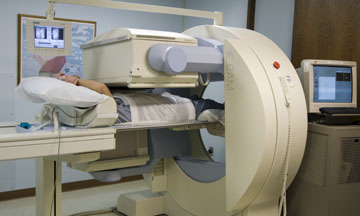Healthcare providers use pharmacological nuclear stress testing to diagnose coronary artery disease and determine heart attack risk. They inject a small amount of radioactive material (radiotracer) and medicine to dilate your blood vessels. Then, they take images of how blood flows in your heart while your heart is at rest and while it’s under stress.
Advertisement
Cleveland Clinic is a non-profit academic medical center. Advertising on our site helps support our mission. We do not endorse non-Cleveland Clinic products or services. Policy

A pharmacological nuclear stress test is an imaging test healthcare providers use to see how blood flows to your heart. It’s also known as cardiac pharmacologic nuclear stress testing or a chemically induced stress test. The information your provider learns from the test can help them diagnose certain heart issues and recommend treatments.
Advertisement
Cleveland Clinic is a non-profit academic medical center. Advertising on our site helps support our mission. We do not endorse non-Cleveland Clinic products or services. Policy
A provider with experience in nuclear medicine imaging performs pharmacological nuclear stress tests.
Your provider may order a pharmacological nuclear stress test to see if you have:
Your healthcare provider may also want you to have this test if you recently had a heart attack (myocardial infarction).
There are two parts to this test, during which providers take two sets of images. During a pharmacological nuclear stress test, healthcare providers:
Follow your healthcare provider’s instructions carefully. Tell your provider about any medications and herbal supplements you take. Before the test, your provider will tell you if you should take your medications or change your medication dosage. They may give you specific guidelines about medications:
Advertisement
If you take heart medications, your provider may tell you to stop taking them before the test. Don’t stop taking any medications unless your provider tells you to stop. Ask your provider any questions you have about taking medications before your test.
Follow your provider’s instructions carefully. You’ll need to avoid:
During the first part of the test, providers take “resting” images of your heart and blood flow. A healthcare provider inserts a thin, flexible tube into your vein (IV catheter). They inject the radiotracer and wait about 30 minutes. Then:
During this part of the test, providers take images of your heart and blood flow under stress. Your provider injects medication into the IV to dilate your blood vessels. Your provider may ask you to walk slowly on a treadmill if you can. If you can’t exercise, you stay on the exam table.
After 30 minutes, you lie still for another 20 minutes. Providers take more images to see blood flow in your heart while your heart is under cardiac stress. Throughout the test, providers monitor your:
A chemically induced stress test typically takes about three to four hours. But some people may have the test over two days. Talk to your healthcare provider about which approach is right for you.
You stay in the test room while your heartbeat returns to normal. Your healthcare provider monitors your blood pressure, EKG and heart rate.
Your provider may tell you not to take certain medications for a while after your test. Follow these instructions carefully.
Pharmacological nuclear stress tests are typically safe. You may have a headache or feel flushed during your test. Some people may experience a fast heart rate (tachycardia). If this happens, your provider may give you medication to regulate your heartbeat.
The radiotracer causes some radiation to stay in your body for a little while. You should:
Some medications you receive during a pharmacological nuclear stress test may cause side effects like:
Advertisement
The test shows if blood flow to your heart is normal. It also shows if certain parts of your heart aren’t getting enough blood at rest or during exercise (under stress). Your provider uses this information to:
Healthcare providers review the images of your heart at rest and under stress. Your provider will talk with you about these images and any next steps.
Let your provider know if you experience any changes in your heart rhythm.
Not necessarily. There are different types of pharmacological stress tests — nuclear and non-nuclear. With nuclear stress tests, your provider uses a radioactive substance (radiotracer) to make your heart and blood vessels visible during imaging. With a non-nuclear stress test, your provider won’t use the radiotracer.
Providers take two sets of images: one when your heart is at rest and one when it’s under stress (during exercise). However, if you can’t exercise, providers give you medicine to simulate the results of exercise on your heart.
Healthcare providers use a pharmacological nuclear stress test to diagnose coronary artery disease and determine your risk of heart attack. Once you complete the test, you’re one step closer to getting more information about your heart. Your provider will talk with you about your test results and any treatment you may need to help keep your heart healthy.
Advertisement
When your heart needs some help, the cardiology experts at Cleveland Clinic are here for you. We diagnose and treat the full spectrum of cardiovascular diseases.

Last reviewed on 09/28/2022.
Learn more about the Health Library and our editorial process.